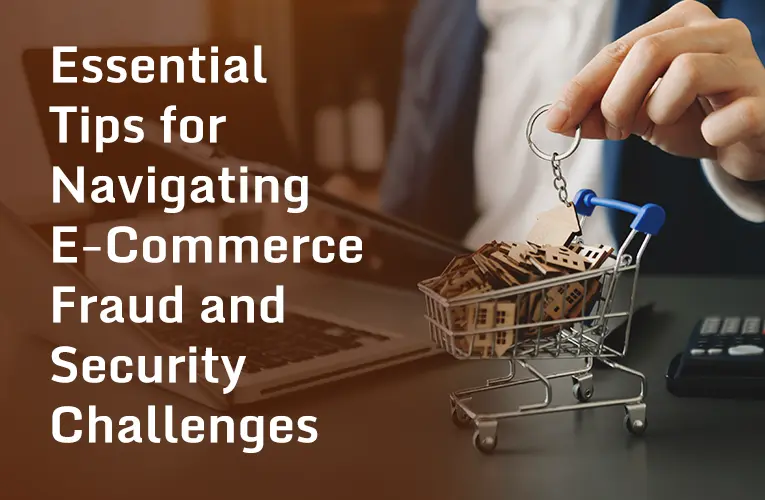Essential Tips for Navigating E-Commerce Fraud and Security Challenges
**1. Understanding Common E-Commerce Fraud Schemes
**1.1 Credit Card Fraud
Credit card fraud is one of the most prevalent types of e-commerce fraud. Criminals use stolen credit card information to make unauthorized purchases.
Tips to Combat Credit Card Fraud:
- Implement AVS and CVV Verification: Use Address Verification System (AVS) and Card Verification Value (CVV) checks to validate card details.
- Employ Fraud Detection Tools: Utilize fraud detection tools and services to identify suspicious transactions and prevent fraudulent activities.
- Monitor Transactions: Regularly monitor transactions for unusual patterns or high-risk activities.
**1.2 Account Takeover
Account takeover occurs when cybercriminals gain unauthorized access to a customer’s account, often through phishing or data breaches. They may then use the account for fraudulent purchases or steal personal information.
Tips to Prevent Account Takeover:
- Implement Multi-Factor Authentication (MFA): Require MFA for user logins to add an extra layer of security.
- Educate Customers: Provide guidance on recognizing phishing attempts and securing their accounts.
- Monitor Login Attempts: Track and analyze login attempts for suspicious activity.
**1.3 Refund Fraud
Refund fraud involves individuals exploiting the return process to receive refunds for items they never purchased or returned. This can be achieved through false claims or using stolen credit cards.
Tips to Address Refund Fraud:
- Verify Return Requests: Implement processes to verify the authenticity of return requests and refunds.
- Use Fraud Detection Solutions: Utilize fraud detection solutions to identify and prevent refund fraud.
- Establish Clear Return Policies: Develop and communicate clear return policies to discourage fraudulent returns.
**1.4 Phishing and Social Engineering
Phishing and social engineering attacks involve tricking individuals into divulging sensitive information, such as login credentials or financial details, through deceptive communications.
Tips to Combat Phishing and Social Engineering:
- Educate Employees and Customers: Provide training on recognizing phishing attempts and social engineering tactics.
- Use Email Filtering: Implement email filtering solutions to detect and block phishing emails.
- Verify Requests: Encourage individuals to verify requests for sensitive information through trusted channels.
**2. Implementing Robust Security Measures
**2.1 Secure Your Website
A secure website is the foundation of e-commerce security. Implementing the following measures can help protect your site from cyber threats:
- Use HTTPS: Ensure your website uses HTTPS to encrypt data transmitted between users and your site.
- Keep Software Updated: Regularly update your website’s software, plugins, and frameworks to patch security vulnerabilities.
- Employ Web Application Firewalls (WAF): Use WAFs to protect against common web-based attacks, such as SQL injection and cross-site scripting (XSS).
**2.2 Protect Customer Data
Customer data protection is critical for maintaining trust and complying with data privacy regulations. Implement the following practices:
- Encrypt Sensitive Data: Use encryption to protect sensitive customer data, such as personal information and payment details.
- Limit Data Access: Restrict access to customer data to authorized personnel only.
- Regularly Backup Data: Perform regular backups of customer data to ensure recovery in case of data loss or breach.
**2.3 Monitor and Respond to Security Incidents
Proactive monitoring and incident response are essential for mitigating the impact of security breaches.
Tips for Effective Monitoring and Response:
- Implement Intrusion Detection Systems (IDS): Use IDS to monitor for suspicious activities and potential threats.
- Develop an Incident Response Plan: Create and regularly update an incident response plan to address security breaches and minimize damage.
- Conduct Regular Security Audits: Perform security audits and vulnerability assessments to identify and address potential weaknesses.
**2.4 Secure Payment Processing
Payment processing security is crucial for preventing fraud and protecting customer transactions. Consider the following measures:
- Use Secure Payment Gateways: Choose reputable and secure payment gateways for processing transactions.
- Implement Tokenization: Use tokenization to replace sensitive payment information with unique tokens, reducing the risk of data exposure.
- Comply with PCI DSS: Ensure compliance with Payment Card Industry Data Security Standard (PCI DSS) to meet security requirements for handling payment data.
**3. Educating and Training Employees
**3.1 Conduct Security Awareness Training
Employees play a critical role in maintaining e-commerce security. Conduct regular security awareness training to educate staff about:
- Recognizing Phishing Attempts: Teach employees how to identify and report phishing emails and suspicious activities.
- Safeguarding Sensitive Information: Provide guidance on handling sensitive customer data securely.
- Following Security Best Practices: Emphasize the importance of following security protocols and procedures.
**3.2 Implement Access Controls
Access controls help limit the risk of internal threats and ensure that only authorized personnel can access sensitive information:
- Use Role-Based Access Controls: Implement role-based access controls to restrict data access based on job roles and responsibilities.
- Regularly Review Access Permissions: Periodically review and update access permissions to ensure they align with current job roles.
**4. Leveraging Technology and Tools
**4.1 Fraud Detection and Prevention Tools
Utilize advanced fraud detection and prevention tools to identify and mitigate fraudulent activities:
- Machine Learning and AI: Implement machine learning and AI-powered solutions to analyze transaction patterns and detect anomalies.
- Real-Time Monitoring: Use real-time monitoring tools to track transactions and identify suspicious activities promptly.
**4.2 Security Software and Solutions
Invest in comprehensive security software and solutions to enhance your e-commerce security:
- Anti-Malware and Anti-Virus Software: Use anti-malware and anti-virus software to protect against malicious threats.
- Data Encryption Solutions: Implement data encryption solutions to secure sensitive information during transmission and storage.
**4.3 Regular Security Updates and Patches
Keep your systems and software up to date with the latest security updates and patches to address vulnerabilities:
- Automate Updates: Configure automatic updates for critical software and systems to ensure timely patching.
- Monitor Security Advisories: Stay informed about security advisories and updates from software vendors and industry sources.
**5. Building Customer Trust and Transparency
**5.1 Communicate Security Measures
Transparency about your security practices can build customer trust and confidence:
- Provide Security Information: Share information about your security measures and protocols on your website.
- Offer Security Certifications: Display security certifications and compliance badges to reassure customers of your commitment to security.
**5.2 Implement Customer Protection Policies
Develop and communicate customer protection policies to address concerns and provide assurance:
- Fraud Protection Policies: Outline your policies for handling fraudulent transactions and protecting customer accounts.
- Privacy Policies: Clearly define your privacy policies and how customer data is collected, used, and protected.
**5.3 Offer Support and Assistance
Provide customer support and assistance to address security concerns and resolve issues:
- Establish a Support System: Set up a dedicated support system for customers to report security issues and seek assistance.
- Respond Promptly: Ensure prompt and effective responses to customer inquiries and concerns related to security.
Conclusion
Navigating e-commerce fraud and security challenges requires a proactive approach and a comprehensive strategy. By understanding common fraud schemes, implementing robust security measures, educating employees, leveraging technology, and building customer trust, you can protect your e-commerce business and customers from potential threats.









